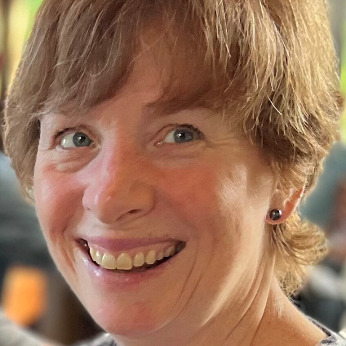By Chrisanne Pennimpede
 Our mother had breast cancer in her 50s, which increased her two daughters’ risk of also developing breast cancer. In 2005, my sister, Lorraine Smith, who was 41, enrolled in an early detection program and had her first mammogram. At the time, mammography reports were not disclosed to the patients, and they were not told anything about the density of their breasts, and what it means. It wasn’t until 2015 that she requested the reports, and learned the higher the density of the breast tissue the more difficult it is to detect a cancerous tumor of any size. Women with very heterogeneously dense breast tissue benefit from additional testing including a bilateral ultrasound and breast MRI.
Our mother had breast cancer in her 50s, which increased her two daughters’ risk of also developing breast cancer. In 2005, my sister, Lorraine Smith, who was 41, enrolled in an early detection program and had her first mammogram. At the time, mammography reports were not disclosed to the patients, and they were not told anything about the density of their breasts, and what it means. It wasn’t until 2015 that she requested the reports, and learned the higher the density of the breast tissue the more difficult it is to detect a cancerous tumor of any size. Women with very heterogeneously dense breast tissue benefit from additional testing including a bilateral ultrasound and breast MRI.
In 2012, Lorraine had a mammogram which detected calcification in the right breast and her density was rated as extreme. No mass was seen, and nothing was done about it. In 2013, she had another mammogram followed by an ultrasound on the right breast that led to a core biopsy. The biopsy found LCIS (lobular carcinoma in situ) and she was referred to a surgical oncologist for consultation. While LCIS is not considered a cancer but a collection of abnormal cell growth, it does increase a person’s risk of developing invasive breast cancer. Despite Lorraine’s very dense breasts, where a tumour could easily hide, and a diagnosis of LCIS, her surgical oncologist didn’t think the situation warranted a breast MRI. She was recommended a lumpectomy on the right side to rule out any invasive lobular carcinoma. In January 2014, the surgical pathology report showed LCIS and no invasive disease. Her surgeon recommended she continue with mammograms and regular breast exams. Lorraine was referred to a medical oncologist for anti-hormonal drug treatment considerations. Lorraine questioned the surgeon about two nodules found in her left breast and whether she should consider a bilateral mastectomy; her surgeon assured her that would be overtreatment.
In February 2014, she met with a medical oncologist to review her case and discuss management options for LCIS. She asked her about the two nodules and if it would be best to consider a double mastectomy to eliminate risk. She acknowledged Lorraine’s worry, but assured her the nodules were cysts and a bilateral mastectomy would be overtreatment. By the summer of 2014, Lorraine felt a lump in her left breast and was referred to finally have a mammogram in November that year. The radiologist confirmed with both a mammogram and ultrasound that there was not just one mass but two in the left breast. It seemed like the two nodules that were deemed benign were in fact cancer. In January 2015, it was confirmed Lorraine had invasive ductal carcinoma. From there things moved quickly, and my sister saw the same surgeon who recommended a bilateral mastectomy and saw the same medical oncologist for additional testing. In March, Lorraine advocated for a sentinel lymph node biopsy and bone scan to be done prior to the bilateral mastectomy surgery. The bone scan came back clear of any evidence of cancer, but the lymph node biopsy showed a small amount of cancer had spread to two out of four of the lymph nodes.
Since it was unknown how far the cancer had spread and Lorraine was facing chemotherapy and radiation, Lorraine knew she was in for a fight for her life and needed to do everything that was necessary. After the biopsy, she had the bilateral mastectomy and reconstruction surgery. In April, Lorraine had a follow up CT scan to ensure the cancer had not spread anywhere else. The medical oncologist indicated something showed up in her spine and recommended she start chemotherapy. Lorraine didn’t feel comfortable with the CT scan results, and asked the radiation oncologist for a PET/CT scan before she started chemotherapy. The scan confirmed metastasis in her spine, her left posterior ilium, and her sternum. She started on Clodronate in early May 2015, then Tamoxifen and Goserelin in late May. Chemotherapy and radiation treatment was aborted. She went on a clinical trial for Ribociclib (a CDK46 inhibitor) – but because it was a double-blind trial, she didn’t know if got the drug or not. She had side effects suggesting she was on the actual drug. Lorraine saw another oncologist about switching to Xgeva and had it covered on compassionate grounds. She stayed on Tamoxifen, Ribociclib, and Goserelin. In September, a PET/CT scan showed further progression and she went off the Ribociclib and Tamoxifen, but stayed on the Xgeva and Goserelin, plus Letrozole. In November 2015, another PET/CT showed she was somewhat stable, and she remained stable from 2016 to the fall of 2018.
A PET/CT scan was done in March 2018 and a little bit of growth on one piece of the spine (L5). She remained stable until October, when she had to have her collapsed expander in her left breast replaced with an implant. Her tumour marker started to rise soon after this surgery, and continued to rise. In March 2019, she had a CT scan, which showed tumors in her lung, liver, and auxiliary (underarms/side of body). Her oncologist put her on Fulvestrant, and agreed to continue Letrozole and Xgeva. By August, a CT scan showed progression in the liver and elsewhere and her treatment was switched to Capecitabine (Xeloda; a chemo pill) in September.
Lorraine knew her options were limited, her cancer was becoming resistant to endocrine therapy, and soon her options would be IV chemotherapy which would greatly reduce her quality of life and lifespan. She started investigating what was new in the way of treatments. Through her research, she was recommended to have a biopsy of her liver for genome testing, specifically CARIS testing. She also contacted CTOAM (Cancer Treatment Options and Management) in Vancouver, BC for a third opinion. While Lorraine waited for a liver biopsy to be scheduled, a CARIS test was done on her original tumor that showed an unusual driver of her original cancer. Lorraine had the liver biopsy done in October 2019 that showed no change to the type of cancer, and a sample was sent to CARIS for a second genome test.
Lorraine contacted the Canadian Breast Cancer Network about how to request access to Abemaciclib on compassionate grounds; Lorraine knew she had a limited period for access. The CTOAM team did a second sequencing test that revealed she had two new mutations, and both were targetable mutations. In January 2020, Lorraine was finding the side effects to Capecitabine difficult. By March, the oncologist agreed to switch her to CTOAM’s recommendations on Fulvestrant, Abemaciclib, and Xgeva. In May, Lorraine’s tumor marker was down and continued to go down and by July, a CT scan showed her lymph nodes decreased 50%; her lung and liver tumors had also decreased. And there were reductions in her auxiliary mets, liver mets, and lung mets, and showed evidence of bone healing. In January 2021, her tumor markers were down again. Unfortunately, in 2022 tumour markers in her liver started rising and the only option was chemotherapy. Lorraine tried it once, but she knew she didn’t want to do chemotherapy. She did the best she could and there was only so much in life one can control. Quality of life was very important to her. She decided not to continue with chemotherapy and passed away on December 3, 2022.
Lorraine’s cancer journey started with a misdiagnosis. She was diligent about getting her yearly mammograms but unfortunately, she was not informed of her dense breasts which should have required further testing. She will be forever known as being a self-advocate for her health care and encourages everyone to question and fight for the best possible care. We believe she brought the lack of patient information regarding breast density to the forefront; as a result, our mammograms now supply density information. If you have dense breasts, please, for Lorraine’s sake, insist on further testing.






